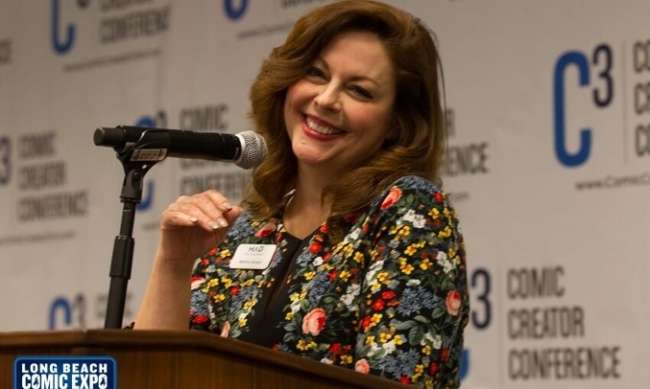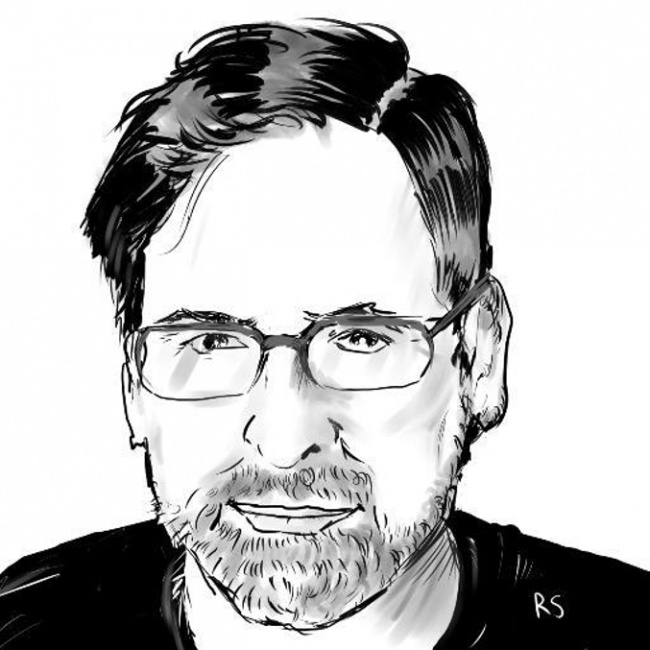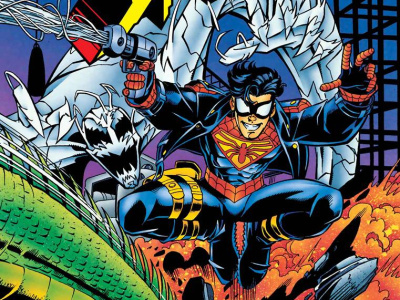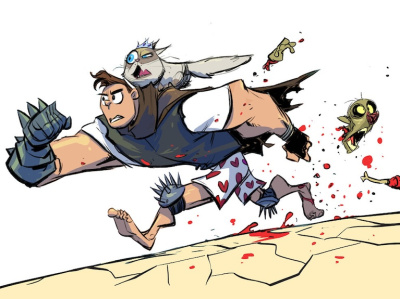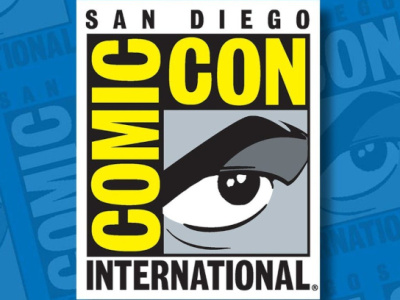Donato, who started out working at Wizard in the early 1990s, helped launch that company’s events division, Wizard World Entertainment, in 1997. At a time when there weren’t many big cons held in the US, she built the Wizard World brand into a successful franchise anchored by popular shows in Chicago, Los Angeles and Philadelphia. When the economy took a hit in 2008, Donato tried her hand at trade event management before launching her own company, MAD Events, to mount the first Long Beach Comic Con in 2009.
Here are some highlights from our conversation, edited for length and clarity.
Rob Salkowitz, ICv2: What’s the unique personality of Long Beach Con that makes it distinct from some of the other big Southern California shows?
Martha Donato, MAD Events: There’s only one way. We have always focused on the creators and the characters. Our exhibitors are real comic book exhibitors. They sell comics. We have publishers who publish comics. When we get celebrity guests, they are connected to comic book characters – like last year, Jason Momoa as Aquaman. We try to keep everything connected to the comics community.
A lot of our competitors have gotten on board the celebrity wagon. They draw big crowds as a result, but that’s not the way we want to go. Our staff holds firm to that, reminding me, in case I ever forget, that we’re a comics convention. Because I have a long history in the convention business – doing licensing, marketing and other stuff on the business side– I have a broader view. Or maybe it’s more myopic [because I’m so focused on the event as a comics event.] Some promoters don’t quite get there’s a comic industry at the heart of all this. We know how rich it is and its potential. That sets us apart. Kris [Longo, MAD Managing Director] and I spend a lot of time discussing how we can improve what we do and serve the whole ecosystem of attendees and publishers.
RS: How has the con grown over the years? What attendance do you expect this year?
MAD: We started off very small. Were only 50,000 square feet of exhibit space [in 2009]. We didn’t draw a huge crowd but we had enough to do the next one. But the growth trajectory from 2013-2016 was significant. We saw unprecedented percentage jumps year over year. In the event biz, you can usually expect 3-4% growth for a mature event. We were 30-40%. We don’t give out attendance numbers, because it can paint a false picture when you’re compared against other shows that are not honest. It’s like you’re chasing a rainbow. This has hamstrung us in terms of attracting major sponsors, but we don’t want to over-promise.
The people who come to Long Beach comic con keep coming back. We have a great retention rate. They come and bring friends because they love the experience, the creator focus, the comic focus. If they want to see celebrities, they’ll go elsewhere.
RS: Have you received inquiries about acquisition?
MAD: Yes, I’ve talked to everyone at some point. There’s a certain appeal. Maybe I can cash out. But the reality is different from your expectations. I think my show is worth X, they say it’s worth Y. There’s a discrepancy. And that’s ok. I’ll just keep my show.
RS: What have been some of the challenges of growing the con?
MAD: One of the biggest challenges is the relationship with the venue and the Visitors Bureau, particularly getting dates that are sustainable. Consumers shows take second place every time to trade shows. We have to wait until an 18-month window opens [after trade shows have locked in their dates]. When that window comes around, what’s left is usually not as good.
Our first year, they said “you can do it on Labor Day.” Not “do you want to do it on Labor Day,” because that’s the busiest weekend of big shows in the year, but “Labor Day is the weekend you get.”
The crowded schedule hasn’t helped either. If you go back and when there weren’t so many shows, we [organizers] tried to be courteous about show dates. These days a lot of shows that are on during holiday weekends because it’s easier for the venues. No trade show wants it [so all the comic conventions happen at the same time]. That’s been a huge challenge.
There’s massive competition in Southern California. It’s not unfriendly competition, but exhibitors have to choose between us, Wonder Con, what’s now called LA Comic Con [formerly Comikaze] and Silicon Valley. It’s a much more subtle concern about how we can get major publishers to support us. It’s not as big a competition for attendees. Our attendees are local mostly.
RS: Do you think there’s still room for growth in the fan con industry or are we nearing saturation?
MAD: If we’re keeping it in the box of “we’re a comic convention,” then we are over saturated. Consolidation is inevitable. It’s happening in front of our eyes.
RS: We live in tense and violent times, where even fan culture is becoming divided and politicized. And we just had a shooting at an eSports event in Florida. What can you as an organizer do to keep your convention physically safe and also safe from the kind of tribalism that’s seeping in to our audience?
MAD: We’ve always taken security seriously. We’ve hired undercover officers. At one point, we were identified as a high risk event because SMG, the management company for the convention center, also managed the venue in Manchester, England where they had had a shooting just a week or two before LBCC. So they imposed a lot of additional mandates for security. They say you have to hire armed, uniformed police, do bag checks, wanding, profiling… and you have to pay for it. We didn’t argue. That’s just how it is if you have a large scale event.
Our insurance company also wants to know. On a management level, it’s the most significant conversation we have. We have to follow it to the letter.
Another factor is that we know who’s coming to our event. Most people buy through our online ticketing system and they have to identify themselves. There’s not as much walk-up traffic.
In terms of keeping attendees safe from harassment and other problems, we have posted language, in signage, in the program, that “cosplay is not consent.” We have a strict anti-harassment policy that we train our staff to enforce. If you violate it, we take action. We’ve had to remove people.
Usually there’s a sense of congeniality but stuff could happen anywhere. We take it seriously. We enforce. Fortunately, we haven’t had a problem.
RS: Let’s talk a little bit about the Creator Conference. What’s the thinking behind that?
MAD: It’s happening on Friday the 7th, in a room in the convention center, before the con opens to the public. We don’t charge more than a nominal fee. It’s non-profit – not intentionally, just low revenue. We offer tracks of programming for creators: one for people just getting started, and another for established professionals who want to learn more about business issues like licensing, PR and self-publishing. It’s followed by a reception and networking event.
Here’s why we do it. The ability to do business at a comic con is essential. People need to attend, to keep up relationships. But at big conventions, we all have to do business in a consumer environment. Exhibitors are busy selling stuff. When you interrupt a professional dealing with fans, it’s not ideal. But professionals have to network.
Also, there’s no formal sense of community, nowhere that we can go to network as professional creators who need to pitch, need to get in front of people who are hiring, need to start those relationships that may pay off down the line. We’re one of the few industries that doesn’t have that. So we want to have a true B2B environment. We need a place to do business.
Creators can cover their costs tabling at the con, but it’s not just the people who are tabling. It’s aspirational. Maybe they’ve drawn stuff at home, but they want a professional portfolio review. We have a generous pro policy. Anyone who is approved for pro registration at the convention can come to the conference.
There used to be stuff but it didn’t catch on. Maybe this won’t either, but that won’t discourage me. We roll it into Long Beach to spread out the expense. My business partner supports it even though it doesn’t make money. It might be me, Kris and 10 people – that’s ok. I’m fortunate that my team supports me in my crazy idea!
The opinions expressed in this column are solely those of the writer, and do not necessarily reflect the views of the editorial staff of ICv2.com.
Rob Salkowitz (@robsalk) is the author of Comic-Con and the Business of Pop Culture.



